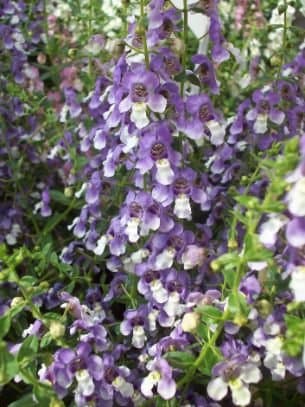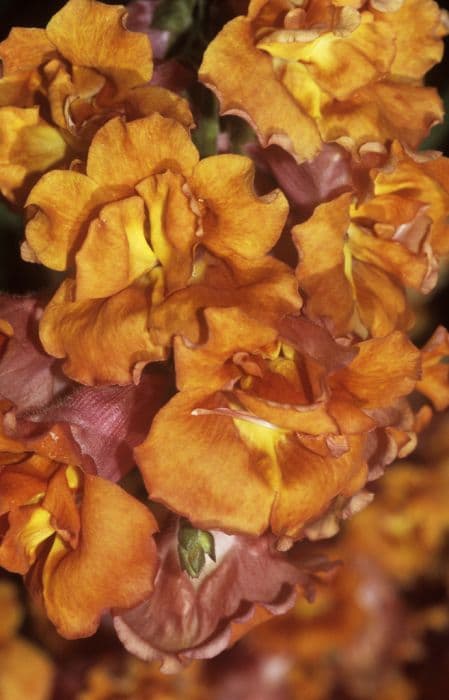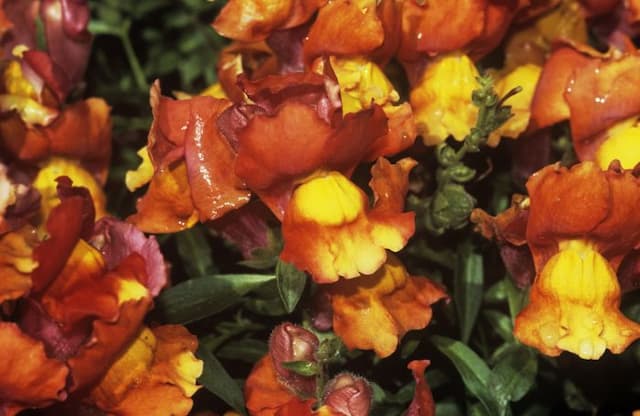Beardtongue Penstemon 'Osprey' (Bird Series)

ABOUT
Penstemon 'Osprey' is a captivating perennial that is known for its attractive features which add a splash of color to any garden. It is part of the Bird Series of penstemons and has a distinctive appearance. The plant boasts a bushy habit with glossy, deep green foliage that forms a lush backdrop for the floral display. The flowers of Penstemon 'Osprey' are particularly striking, tubular in shape, and hang in clusters. They are predominantly white but have a lovely hint of pale pink that suffuses the petals, giving them a soft, romantic appearance. Each individual flower is accented with a delicate pink throat, which adds depth and contrast to the bloom. The flowers are neatly arranged on tall spires which rise elegantly above the foliage. These blooms are not only visually appealing but are also known to attract pollinators such as hummingbirds and bees to the garden, thanks to their nectar-rich composition. The flowering season for Penstemon 'Osprey' typically extends through summer, offering a prolonged period of ornamental interest. Overall, the appearance of Penstemon 'Osprey' embodies a mix of grace and charm, contributing texture, color, and a vertical element to beds, borders, and cottage garden settings. With its vibrant blossoms and dense foliage, this plant creates a stunning visual impact without requiring any dimensions for its size to be recognized.
About this plant
 Names
NamesFamily
Plantaginaceae
Synonyms
Beard Tongue, Beardtongue
Common names
Penstemon 'Osprey'
 Toxicity
ToxicityTo humans
Penstemon, commonly known as beardtongue, is generally not considered to be toxic to humans. There are no known toxic effects from ingesting parts of the Penstemon 'Osprey' plant. However, as with any plant, individual allergic reactions or sensitivities could occur, and it is always advisable to exercise caution and avoid ingesting parts of plants that are not generally recognized as edible.
To pets
Beardtongue is not known to be toxic to pets either. Penstemon 'Osprey', like other members of the Penstemon genus, does not typically pose a risk of poisoning if pets consume parts of the plant. However, pet owners should always be cautious and prevent pets from ingesting plants not intended for consumption, as individual animals might have sensitivities or allergic reactions, and ingesting non-food plants can sometimes lead to gastrointestinal upset.
 Characteristics
CharacteristicsLife cycle
Perennials
Foliage type
Semi-deciduous
Color of leaves
Green
Flower color
Pink
Height
2 feet 6 inches (0.76 meters)
Spread
2 feet (0.61 meters)
Plant type
Herb
Hardiness zones
6
Native area
North America
Benefits
 General Benefits
General Benefits- Attracts Pollinators: Penstemon 'Osprey' produces flowers that attract bees and hummingbirds, essential for pollination.
- Drought Tolerance: Once established, this plant is drought-resistant, making it suitable for xeriscaping and water-wise gardens.
- Long Blooming Period: It boasts a long flowering season, often from late spring through summer, providing extended color and interest.
- Low Maintenance: Penstemon 'Osprey' requires minimal care once established, making it ideal for gardeners seeking low-maintenance options.
- Cold Hardy: It is capable of surviving in cooler climates, down to USDA hardiness zone 4.
- Ornamental Appeal: With its attractive foliage and tubular flowers, it adds aesthetic value to garden landscapes.
- Wildlife Habitat: Provides shelter and nectar for wildlife, promoting biodiversity.
- Versatility: Suitable for borders, rock gardens, and as a cut flower in floral arrangements.
- Non-Invasive: Unlike some ornamental plants, Penstemon 'Osprey' does not typically spread beyond its intended area.
- Erosion Control: Its root system can help stabilize soil and prevent erosion on slopes.
- Deer Resistance: It is known to be resistant to browsing by deer, beneficial in areas where deer are a common garden problem.
 Medical Properties
Medical PropertiesThis plant is not used for medical purposes.
 Air-purifying Qualities
Air-purifying QualitiesThis plant is not specifically known for air purifying qualities.
 Other Uses
Other Uses- Ink Production: The flowers of Penstemon 'Osprey' can be used to create a natural dye or ink, which artists and crafters may find particularly useful for traditional dyeing techniques or ink-making.
- Floral Art: The distinctive tubular flowers and attractive foliage of the plant can be incorporated into floral art and arrangements, providing unique form and color.
- Educational Tool: Penstemon 'Osprey' can be employed in educational gardens to teach about pollination, as it attracts bees and other pollinators.
- Garden Photography: With its striking blooms, Penstemon 'Osprey' serves as a great subject for garden photography, appealing to both amateur and professional photographers.
- Culinary Garnish: Although not widely recognized as an edible flower, Penstemon petals can make a colorful garnish for salads and desserts, after ensuring they are free of pesticides and safe for consumption.
- Ecosystem Support: Planting Penstemon 'Osprey' can contribute to supporting local ecosystems by offering nectar and habitat to a variety of insects and birds.
- Theme Gardens: The plant can be used in thematic garden designs, such as a "bird garden" which focuses on plants that attract and support bird life.
- Color Themed Planting: With its specific shade of bloom, Penstemon 'Osprey' can play a pivotal role in color-themed garden designs, such as blue and white gardens.
- Waterwise Landscaping: Due to its drought-tolerant properties, the plant can be utilized in xeriscaping to create water-efficient landscapes.
- Scented Gardens: Although it is not known for a strong fragrance, Penstemon 'Osprey' can contribute subtle floral notes to a scented garden designed for olfactory enjoyment.
Interesting Facts
 Feng Shui
Feng ShuiThe Beard Tongue is not used in Feng Shui practice.
 Zodiac Sign Compitability
Zodiac Sign CompitabilityThe Beard Tongue is not used in astrology practice.
 Plant Symbolism
Plant Symbolism- Attraction: Penstemons often symbolize attraction due to their vivid colors and shape, which are known to attract hummingbirds and butterflies, consequently also signifying an allure to things of beauty and nature.
- Diversity: The variety in the penstemon species typifies diversity, embracing various environments and conditions, which can parallel the idea of versatility and adaptability in life.
- Health and Vitality: The robust nature of penstemons, with their capacity to thrive in challenging conditions, may represent good health and vigorous life.
- Endurance: Given their hardy character, penstemons could be used to symbolize endurance or the ability to cope with adversity.
 Water
WaterBeardtongue should be watered regularly, especially during the first growing season to establish a deep, extensive root system. Watering should be done deeply, but infrequently, to encourage the roots to reach down into the soil. Generally, one inch of water per week, either from rainfall or manual watering, is sufficient. During the heat of summer, you may need to water every other week if there has been no significant rainfall. In cooler weather or when the plant is established, you can reduce the frequency. Always check the top few inches of soil for dryness before watering again. Avoid overhead watering to keep the foliage dry and prevent disease.
 Light
LightBeardtongue thrives in full sun, which means at least 6 to 8 hours of direct sunlight each day. The ideal spot for planting beardtongue is where it can receive unfiltered sunlight throughout the day; however, it can tolerate partial shade, especially in hotter climates. Too much shade will result in weak growth and fewer blooms.
 Temperature
TemperatureBeardtongue is cold-hardy and can withstand temperatures as low as 20 degrees Fahrenheit, but it grows best in temperatures between 60 to 75 degrees Fahrenheit. Hot temperatures above 90 degrees Fahrenheit can stress the plant, so some afternoon shade might be beneficial in hotter climates to prevent overheating.
 Pruning
PruningBeardtongue benefits from pruning to promote bushier growth and more flowers. Deadheading spent blooms encourages a second flush of flowers and prevents the plant from putting energy into seed production. Pruning should be done after the first flowering, and then again in late fall or early spring to shape the plant and remove any dead or damaged stems. The best time for major pruning is after the last frost in spring.
 Cleaning
CleaningAs needed
 Soil
SoilBeardtongue 'Osprey' thrives in well-draining soil enriched with organic matter. Aim for a pH between 6.0 and 7.5. A mix of loam, peat, and sand in equal parts, with a bit of compost, can be ideal.
 Repotting
RepottingBeardtongue 'Osprey' typically needs repotting every 2-3 years to refresh the soil and accommodate growth.
 Humidity & Misting
Humidity & MistingBeardtongue 'Osprey' prefers moderate humidity and does well in typical outdoor conditions without specific humidity requirements.
 Suitable locations
Suitable locationsIndoor
Provide bright light and good air circulation for indoor Beardtongue 'Osprey'.
Outdoor
Plant in sun or part-shade in well-drained soil for outdoor Beardtongue 'Osprey'.
Hardiness zone
5-9 USDA
 Life cycle
Life cyclePenstemon 'Osprey', commonly known as Beardtongue, begins its life as a seed that germinates in the spring when soil temperatures warm sufficiently. The seedling emerges and establishes a small rosette of leaves at the soil surface, developing a root system. As it matures, it develops upright stems with lance-shaped leaves and eventually produces clusters of tubular, two-lipped white and pink flowers, usually in its second year. These flowers are attractive to pollinators such as bees and hummingbirds, which aid in the cross-pollination process. Once pollinated, the flowers produce capsule-like fruits that release small seeds, completing the reproductive cycle. The plant may die back in the winter, especially in colder climates, but as a perennial, it can survive to regrow from its roots in the following spring.
 Propogation
PropogationPropogation time
Spring-Early Summer
The most popular method of propagating Penstemon 'Osprey' is by seed. To do so, you would sow the seeds in early spring or fall directly into a well-draining soil mix. The soil temperature should ideally be around 60-70°F (15.6-21.1°C) for optimal germination. Cover the seeds lightly with soil because they require light for germination, and keep the soil consistently moist but not waterlogged. Seedlings should emerge in two to three weeks. Once the seedlings have grown large enough to handle, usually when they have several sets of true leaves, they can be transplanted into individual pots or to their final location in the garden.









